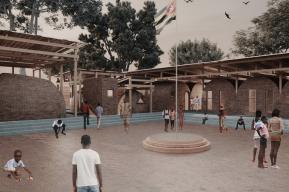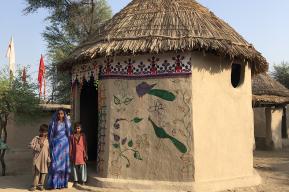فكرة
في البيرو، تزايد أعداد المهاجرين لأسباب مناخية

نظرا لامتداد السواحل على حوالي 3.000 كم، ووجود أنظمة بيئية شديدة التأثّر بالتغيّر المناخي، تُعتبر البيرو واحدة من البلدان التي تشهد ترابطا وثيقا بين الأحداث الطبيعية وتنقّل البشر.
لورا بيرديخو
اليونسكو
بين سنتي 2008 و2019، اضطر حوالي 656.000 من بين سكان البلاد البالغ عددهم 33 مليون نسمة، إلى التنقّل إثر حدوث كوارث طبيعية، حسب مركز رصد التنقلات الداخلية (IDMC). ويُتوقّع أن تبلغ هذه التنقلات، بحلول سنة 2100، مستويات غير مسبوقة مع تصاعد حادّ لوتيرة التقلّبات الطبيعية واشتدادها.
إنّ الكلمة المفتاح، هنا، هي "هوايكو" huayco، كما تقول ليليانا ماركيز، ضابطة الصّورة بالتلفزيون في ليما، مضيفة: "ذلك هو الاسم الذي يُطلق على الفيضانات التي تتسبّب فيها، كل صيف تقريبًا، ظاهرة النينيو El Niño، والتي أُجبِرتنا على التّعايش معها في بلاد يعود فيها تاريخ أول نزوح مُكثّف مرتبط بالمناخ إلى القرن الثامن عشر، عندما خرج النهر، الذي يسقي مدينة زانيا Zaña، عن مجراه، وأجبر المدينة كلها على الرّحيل".
تعتبر ظاهرة النينيو/التذبذب الجنوبي (الإينوا ENOA) العامل الأول للتغيرات الطبيعية للمناخ في البيرو. وهي ظاهرة تتميّز بتعاقب مراحل احترار (النينيو El Niño) ومراحل انخفاض (لدرجة الحرارة النينيا Niña) على سطح البحر في المحيط الهادئ، تتسبب في حدوث تغيّرات في الغلاف الجوي قد تصل إلى تغيير عميق في المناخ، لا سيّما في أنظمة التساقطات. وكان من تبعات آخر موجة نينيو ساحلية الإلقاء، سنة 2017 بما يقرب من 300.000 شخص على الطرقات. غير أنه، علاوة عن ظاهرة النينيو، تتعرض كلّ من الأنظمة البيئية الثلاثة في البلاد إلى مخاطر خصوصية يمكن أن تتسبّب في موجات هجرة هائلة.
تزايد المخاطر الطبيعية
علاوة على تعرّض سكان الكوستا، المنطقة الساحلية التي تأوي الجزء الأكبر من السكان وتُعتبر مركز اقتصاد البلاد، إلى تأثيرات الإينوا باعتبارهم في الخطّ الأوّل، فهم عرضة أيضًا للجفاف المتكرّر في فترات انحباس الأمطار، وبدرجة أقل، للارتفاع الشديد في درجات الحرارة وحرائق الغابات والرّياح العاتية.
في سييرا، منطقة الهضاب المرتفعة، ترتبط معظم المخاطر المناخية بالمياه، إضافة إلى الحرارة المرتفعة وموجات الحرّ في بعض المناطق، أو إلى الحرارة المنخفضة جدًا والتي تبلغ التجمّد في أماكن أخرى مثل كوزكو. ومن أكبر المخاطر، التي يمكن أن يتسبب تسارعها في هجرة %28 من سكان المناطق المرتفعة، تراجع الأنهار الجليدية الذي يهدّد أحد مصادر المياه الرئيسية في البلاد.
وأخيرًا، تشهد السيلفا، أو الغابة الاستوائية، تعدّد الفيضانات الكبرى، أو، على العكس من ذلك، فترات جفاف شديد، وانهيار الضفاف، والانجراف، وتراجع الغابات، والمخاطر الصحية الناجمة عن فرط الحرارة.
في بلاد تتجاوز فيها نسبة الفقر %20، وتعمّقت فيها التفاوتات الاجتماعية مع تفشّي الجائحة، فإن هذه التهديدات تزيد من حدّة الهشاشة الاجتماعية والاقتصادية للسكان. حاليًا، فإنّ نصف المجال الترابي للبيرو مهدّد بالكوارث المتكرّرة؛ وثلث السكان يعيشون في مناطق معرّضة للخطر، وأكثر من 9 ملايين شخص مُعرّضون للأمطار الغزيرة والفيضانات المتكرّرة والانهيارات والانجرافات الأرضية؛ في حين يتهدّد الجفاف حوالي 3.5 ملايين نسمة.
في أسوأ السيناريوهات، أي في حالة احترار الأرض بأكثر من 4 درجات مئوية بحلول سنة 2100، تخيّم على بلد الأنديز ثلاثة تهديدات كبرى سوف تتسبّب في تنقّل عشرات الآلاف من الأشخاص، وفي التوتّر الحراري "الساخن" في منطقة الأمازون، والذوبان شبه الكامل للأنهار الجليدية في جبال الأنديز، وحدوث دورات نينيو أكثر حدّة من ذي قبل قد تُعرّض سكان السواحل إلى الخطر.
تنقّلات داخلية
تعتبر الهجرة في البيرو، سواء كانت دائمة أو مؤقتة وداخلية أو خارجية، من التقاليد التاريخية. فسكان البيرو يهاجرون لتحسين ظروف عملهم، ووضعهم الاجتماعي أو التعليمي، وللهروب من الضغوط البيئية في الفترة الأخيرة. هذه التدفقات التاريخية خلقت شبكات قوية شجّعت على الهجرة في اتجاه المدن والساحل وساعدت على حركة التحويلات المالية نحو المناطق الريفية في البيرو.
ويتسبّب المناخ في الهجرة الداخلية بالخصوص، التي أصبحت ديناميكيتها تعتمد حاليا على معايير التمايز الاجتماعي سواء من حيث السن (الشبان هم أكثر المغادرون)، أو مستوى الدخل (الفقراء هم الأكثر عرضة للهجرة)، أو الجنس (تنقّل الرجال يفوق بقليل تنقّل النساء).
على السواحل، يتنقل الصيادون على طول الشريط الساحلي وفق توفر الموارد البحرية التي تحدّدها ظاهرة الإينوا. في حين يهاجر فلّاحو بٍييُورا (في الشمال) بشكل مُؤقّت أثناء فترات الجفاف بحثا عن تنويع دخلهم. وفي الهضاب المرتفعة، أدّى التغيّر المناخي إلى التسريع في أدفاق الهجرة التاريخية الواسعة حيث يهاجر الناس بسبب موجات البرد والجليد، ونقص المياه الناجم عن تراجع الأنهار الجليدية، والتغيرات الطارئة على نظام التساقطات. وفي مناطق سيلفا، يهاجر الفلاحون بالخصوص مؤقتـا ومن باب الاحتياط خلال موسم الأمطار لضمان أمنهم الغذائي.
وغالبًا ما تنطوي الأماكن المقصودة على مُجازفات ومخاطر (مجاري الأنهار، سهول مُعرّضة للفيضانات، مرتفعات يشحّ فيها الإمداد بالماء في ضواحي المدن، إلخ)، ممّا قد يؤدي، حسب المنظمة الدولية للهجرة إلى "ارتفاع التكلفة النفسية-الاجتماعية لدى الأشخاص الذين يفقدون منازلهم وسبل عيشهم وممتلكاتهم".
في هذا السياق، يكتسي دور وسائل الإعلام في التعامل مع التنقلات الناجمة عن التغير المناخي أهمية إضافية. تقول ليليانا ماركيز، معربة عن أسفها: "ما زال ضحايا هوايكو 2017 يعيشون في خيام في ليما بعد مضيّ ثلاث سنوات". أما بابلو إسكريبانو، أخصائي الهجرة وتغير المناخ في مكتب المنظمة الدولية للهجرة بالولايات المتحدة، فيلاحظ بدوره: "هناك اهتمام متزايد بالسّرديات البشرية المرتبطة بالهجرة المناخية".
ويضيف: "هذه السّرديات هامّة لأنها تُقرّب المتلقّي من الواقع الذي يعيشه ضحايا التغيّر المناخي والهجرة القسرية."
ظاهرة عالمية
يندرج تزايد الهجرة بسبب المناخ في البيرو ضمن توجّه عالمي كما هو الشأن في عدد من البلدان الأخرى التي بلغت مستويات عالية - مثل بنغلاديش، وفيجي، وغانا، وتنزانيا، على وجه الخصوص–.
ففي أبريل المنقضي، نشرت المفوضية السامية للأمم المتحدة لشؤون اللاجئين تقريرًا يبيّن أنه، خلال العشرية الماضية، أثارت الأحداث المُتّصلة بالمناخ تنقلات جديدة بمعدل 21.5 مليون حالة كل سنة، أي ضعف ما تسبّبه النّزاعات وأعمال العنف.
وحسب بيانات مركز رصد التنقلات الداخلية، لسنة 2020، أُجبر 30.7 مليون شخص، في العالم، على المغادرة بسبب الكوارث الطبيعية. وقد مثّلت الظواهر المناخية %98 من أسباب التنقل المرتبطة بالكوارث.
تقول ألكسندرا بيلاك، مديرة مركز رصد التنقلات الداخلية: "يُظهر تقريرنا، أيضًا، أن معظم الأشخاص الذين ينتقلون يبقون داخل بلدهم الأصلي"، معبّرة عن خشيتها من أن تؤدي المخاطر "إلى احتداد التفاوتات الاجتماعية والاقتصادية".
استجابة في طور التنظيم
يُؤكّد يوهان روكستروم، مدير معهد البحوث حول تأثير التغيّر المناخي في بوتسدام، أن "نموذج البيرو يبيّن أن تأثيرات التغيّر المناخي وتدهور النظم البيئية يزيدان من مخاطر تنقّل البشر وهجرتهم".
ويلاحظ بابلو إسكريبانو أنه "بالنظر إلى أنّ البيرو لديها أنظمة بيئية (سييرا، كوستا، سيلفا) مشتركة مع البلدان المجاورة، فإن هذه البلدان يمكن أن تتقاسم معها عددا من الحقائق والأوضاع. وأنّ الذي يميّزها عن بعضها البعض هو طبيعة استجابة السلطات".
ويضيف أن "أمريكا اللاتينية تعتبر رائدة في وضع سياسات في مجالات الهجرة والبيئة والتغيّر المناخي، ربما بنفس القدر ومنطقة المحيط الهادئ. ففي العديد من بلدان المنطقة، مثل البيرو أو غواتيمالا أو بليز أو تشيلي، تُبذل، حاليا، جهود لتحسين المقاربة السياسية للهجرة الناجمة عن التغيّر المناخي."
ورغم بعض الثغرات القانونية، فقد اعتمدت البيرو منذ سنة 2000 العديد من الأطر المرجعية حول التغيّر المناخي، وتتوفّر لديها، الآن، مجموعة واسعة من الأدوات القانونية والسياسية لتأطير الهجرة الناتجة عن المناخ.
ويؤكد بابلو إسكريبانو أنه، لئن ظلّت معظم الهجرات المناخية داخلية، وتعود بالتالي إلى مسؤولية الدول، فهناك، أيضا، مبادرات إقليمية جارية الآن.
ثم يُضيف مُوضّحا: "في أمريكا اللاتينية، يُعتبر المؤتمر الجنوب-أمريكي حول الهجرة المنظمة الإقليمية ذات المقاربة الأكثر تقدّما بخصوص الهجرة المناخية، وهي تقوم حاليًا برسم خرائط السياسات المتعلقة بالهجرة والبيئة والتغيّر المناخي". وهي أداة ضروريّة بالنظر إلى التأثير المستقبلي للأخطار الطبيعية على سكان القارة.
قراءات ذات صلة:
تغيّر المناخ يهدّد بنزاعات جديدة، رسالة اليونسكو، أبريل - يونيو 2018
لاجئو المستقبل سيهاجرون لأسباب مناخية، رسالة اليونسكو، عدد 10، 2009.
اشترك في رسالة اليونسكو لمتابعة الأحداث. الاشتراك في النسخة الرقمية مجاني %100.
Laura Berdejo
UNESCO
Between 2008 and 2019, around 656,000 of Peru’s 33 million inhabitants were forced to move because of natural disasters, according to the Internal Displacement Monitoring Centre (IDMC). It is estimated that by 2100, these movements could reach unprecedented levels, as the frequency and intensity of environmental hazards are expected to skyrocket.
“The key word here is huaico”, explains Liliana Márquez, a camerawoman for a television channel in Lima. “That’s what we call the flash floods caused by torrential rains that originate from the El Niño phenomenon, almost every summer. These have now become recurrent in a country where the first major climate-related population movement dates back to the eighteenth century, when the Zaña river overflowed and the entire city had to migrate.”
The El Niño Southern Oscillation (ENSO) is the most consequential driver of natural climate variability in Peru. Characterized by warming (El Niño) and cooling (La Niña) events of the ocean surface temperature in the Pacific, the phenomenon causes atmospheric changes that can profoundly affect the climate – particularly rainfall patterns.
Its most recent coastal occurrence, in 2017, led to nearly 300,000 people being displaced. But beyond the El Niño phenomenon, each of Peru’s three ecosystems is exposed to specific risks that are capable of contributing to massive waves of migration.
El Niño displaced nearly 300,000 people when it last occurred in 2017
Natural risks on the rise
While the inhabitants of the costa – the coastal region where most of the country’s population and economy are concentrated – suffer the full effects of ENSO, they are also affected by recurring droughts, periods without rain and, to a lesser extent, high and extreme temperatures, forest fires, and strong winds.
In the sierra, the highland region, most of the meteorological hazards are linked to water – although exposure to high temperatures and extreme heat in some areas, and extremely cold and freezing temperatures in places such as Cuzco, also predominate. One of the greatest dangers here is the retreat of glaciers, the acceleration of which could cause the migration of twenty-eight per cent of the inhabitants of the highlands, and also threaten one of the country’s principal fresh water sources.
Finally, the selva, with its rainforests, is experiencing an increasing number of large-scale floods. At the other extreme, there are severe droughts, riverbank collapses, erosion, deforestation, and the risks of extreme heat stress.
In a country where the poverty rate is more than twenty per cent, and where social inequalities have increased considerably due to the pandemic, these environmental threats further accentuate the socio-economic vulnerability of the population.
According to a 2021 assessment of Peru by the Potsdam Institute for Climate Impact Research (PIK), and the International Organization for Migration (IOM), half of Peru’s national territory is exposed to recurring hazards, and one third of the population uses exposed space. More than 9 million people are exposed to heavy rains, floods, flash floods and landslides, 7 million to low and very low temperatures, and almost 3.5 million to droughts.
In the worst-case scenario of global warming of over 4 °C by 2100, the Andean country would face three major threats, which could cause tens of thousands of people to be displaced – extreme heat stress in the Amazon region, the almost total melting of glaciers in the Andes, and more intense El Niño events that would endanger coastal populations.
Internal displacements
In Peru, migration – whether permanent or temporary, internal or external – has always existed historically. Traditionally, fewer people have migrated to the country than those who have left – to improve their job prospects, for social and educational opportunities, and increasingly, to escape environmental hazards. “These historical flows have resulted in strong migration networks across the country that pull new migration towards cities and the coast and boost remittances to rural areas,” the IOM notes.
Climate migrants tend to move mainly within their country’s borders, where dynamics depend on social demographics – age, with young people leaving more often; deprivation, with poor people more likely to migrate; and gender, with men slightly more likely to move than women.
Inhabiting a land of extreme landscapes and climates, the people of Peru have developed coping and adaptation strategies to deal with hazards where they live. In the costa, fishermen move along the coast, depending on the availability of marine resources determined by ENSO. And farmers in Piura, in the country’s north, migrate temporarily during droughts to diversify their income.
In the highlands, the effects of climate change have accelerated the historically large flows of migrants due to cold waves and freezing weather, water shortages caused by glacier retreat, and changes in rainfall patterns. In the selva region, farmers migrate mainly as a temporary and precautionary measure during the rainy season, to mitigate food insecurity.
Many migrants have no choice but to resettle in areas that are also exposed to multiple hazards – such as riverbeds, floodplains and water-stressed hills in the outskirts of cities. “Such disaster displacement can take a high psychosocial toll on people who have lost their livelihoods and assets, including homes and other infrastructure,” the IOM points out.
In this context, the role of the media in climate displacement management is increasingly important. “The victims of the 2017 huaico are still living in tents in Lima, three years later,” notes Márquez.
“There is a growing interest in the human stories behind climate migration,” remarks Pablo Escribano, Regional Thematic Specialist in Migration, Environment and Climate Change in IOM’s Regional Office for Central America, North America and the Caribbean.
“These stories are important because they bring audiences closer to the reality of the people who are affected by climate change and forced migration,” he adds.
A global phenomenon
The increase in climate migration in Peru – as in other countries with high rates, such as Bangladesh, Fiji, Ghana, and Tanzania – is part of a worldwide trend. In April 2021, UNHCR, the UN Refugee Agency, published a report showing that, over the past decade, weather-related events triggered an average of 21.5 million new displacements each year – over twice as many as the displacements caused by conflict and violence.
According to a 2021 report by IDMC, 30.7 million people worldwide were displaced because of geophysical and weather-related disasters in 2020. Meteorological events accounted for ninety-eight per cent of disaster displacement.
In 2020, 30.7 million were displaced because of geophysical and weather-related disasters
“Our report also shows that most of the people displaced by these disasters remain in their home countries,” explains Alexandra Bilak, director of IDMC. She fears that this “will further exacerbate socio-economic inequalities.”
An organized response
“The PIK-IOM report puts the evidence on the table,” notes Johan Rockström, director of PIK. “In Peru, we are seeing the impacts of how climate change and ecosystem degradation amplify the risks of human displacement and migration, already occurring now at 1.2 ℃ of global warming.”
“Given that Peru shares its ecosystems – sierra, costa, selva – with its neighbours, some realities may be shared too,” says Escribano. “What differentiates them is the response of the authorities.”
“The Latin American region has been a pioneer in the development of policies on migration, the environment and climate change, perhaps as much as the Pacific,” he adds. “In several countries in the region – like Peru, Guatemala, Belize and Chile – efforts are underway to improve the policy response to climate migration.”
Though some legal gaps remain, Peru has established several reference frameworks on climate change since 2000, and now has a wide range of legal instruments and policies applicable to climate migration.
Although most climate migrations remain internal and are therefore the responsibility of states, regional initiatives are also being developed, Escribano notes.
“In South America, the regional organization with the most advanced approach to climate migration is the South American Conference on Migration (SACM),” according to him. “It is currently working on mapping policies on migration, the environment, and climate change.”
That is an increasingly evident necessity, given the future impact of natural disasters on the continent’s population.

In the same issue







